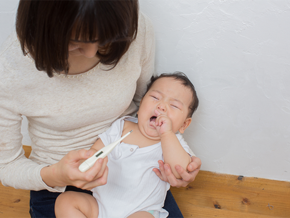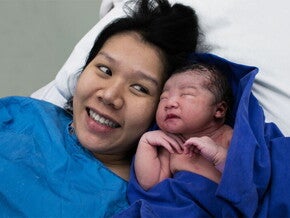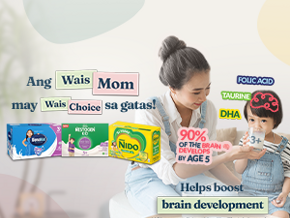
30 Must-Know Terms to Guide You Through the Early Childhood Stage
The early childhood stage is the period from birth to around age 8. But for many first-time parents, the most overwhelming parts happen during their little one's first 2 years. It doesn't help when some of the language around child development really sounds like it's meant for doctors or textbooks, not sleep-deprived new parents.
So, we've put together a parenting cheat sheet of some of the most important words you need to know about your child's development, care, and feeding. Hopefully, it helps you feel more prepared for your parenting adventure!
Terms to Know About Your Baby's Development and Behavior
From the moment your baby lifts their head or starts making those belly laughs, they're picking up essential skills. Knowing these terms can help make checkups with your doctor a lot easier.
1. Cognitive development
The American Psychological Association (APA) Dictionary of Psychology defines cognitive development as the growth and development of thinking skills. It refers to how your child makes sense of the world—how they see things, remember information, solve problems.
And this kind of learning depends on a healthy brain development, the American Academy of Pediatrics (AAP) says, which is shaped by both early experiences and care.
2. Developmental milestones
Guidelines published in Pediatrics show that developmental milestones are skills or behaviors most children reach within a certain age range. These milestones are grouped into different areas of development: social-emotional, motor skills, cognitive, and language and communication.
Pediatricians use these milestones to check how your child is growing and learning over time. This month-by-month guide on developmental milestones can help you when your pediatrician asks about your child's progress during checkups.
3. Gross motor skills
Gross motor skills are abilities that involve large muscles of the body, enabling activities such as walking, running, etc. These skills are essential for everyday movements and physical activities.
4. Fine motor skills
If gross motor skills are big movements, fine motor skills involve smaller, more precise movements. According to AAP's developmental milestone checklist, examples of fine motor skills include picking up a small toy or holding a spoon. As your baby grows, you’ll notice their hands and fingers becoming more coordinated (see "pincer grasp" below).
5. Language development
Based on the AAP developmental milestone checklist, language development refers to your child's growing ability to use words and sentences to communicate, which starts well before their first words. Their baby talk begins with sounds like cooing and babbling as you engage with them. Over time, they begin to gesture to express their wants, learn to name objects, and follow simple instructions.
6. Developmental delay
According to the Centers for Disease Control and Prevention (CDC), a milestone or developmental delay means your child did not reach or is taking longer than expected to reach a developmental milestone compared to children the same age. A delay may mean it's just taking your child a while to learn how to walk or say that first word. However, always bring it up with your pediatrician the moment you notice it.
7. Moro reflex
The MedlinePlus Medical Encyclopedia defines the Moro reflex as a type of involuntary response when a newborn is startled or feels as if they're falling. Their arms may suddenly jerk outward sideways with the palms up and the thumbs flexed. This reflex, also known as Moro response, typically goes away when your baby is three or four months old.
The Moro reflex tells your pediatrician that your baby's nervous system and brain are developing properly. If this reflex is absent, it signals your doctor to take a closer look at your baby to rule out any nerve or brain issues.
8. Pincer grasp
One of the key fine motor skills is the pincer grasp, the movement your baby uses to pick up small objects between their thumb and index finger. This milestone in hand coordination usually develops around 6 months old, a time when your baby starts on solid foods.
9. Rooting reflex
According to Stanford Medicine Children's Health, the rooting reflex helps newborns find the breast or bottle when they're ready to feed. When you gently stroke your baby’s cheek, they'll turn their head toward the touch and open their mouth. It's the strongest during the first weeks and lasts for four months.
10. Social-emotional development
Based on the AAP developmental milestone checklist, social-emotional development is how your baby begins to understand emotions, form relationships, and respond to others. And it doesn't start at toddlerhood but as early as 2 months old. They show social-emotional development skills when they smile back at you, show fear around strangers, or seek you out when they're upset.
11. Special needs
Special needs is a term used to describe a child who requires additional support due to physical, cognitive or emotional developmental challenges.
However, the APA Dictionary of Psychology says special needs is an outdated term for "a child with disabilities who requires special education, specialized healthcare, or other functional needs or services."
To promote more inclusive language, the United Nations suggests using terms like "person with disability" or "person with [type of impairment]."
Words You'll Often Hear and Read About Feeding Your Baby

Burping your baby after feeding can help prevent the build-up of air in the tummy.
Early parenting can feel like all you do is feed your baby and worry whether they're getting enough milk. Ease your mind with these terms.
12. Breast milk
You make breast milk! It's the first and primary source of nutrition for your baby and naturally changes to meet your baby's needs. Breast milk is called liquid gold because it contains the right mix of nutrients, antibodies, and fat your baby needs to grow healthy.
13. Cluster feeding
The Australian Breastfeeding Association describes cluster feeding as a baby wanting to feed more frequently than usual, often in short, back-to-back sessions over a few hours. It usually happens in the evening or during growth spurts in the first few months. While it can feel non-stop, cluster feeding actually helps increase your breast milk supply.
14. Complementary feeding
The World Health Organization (WHO) says complementary feeding starts when your baby needs additional nutrients that breast milk alone cannot provide. This typically coincides when your baby is ready for solid foods (see #18), which "complement" breast milk, not replace it.
15. Infant formula
Infant formula milk is designed to provide the nutrients your baby needs if, for any reason, you are unable to breastfeed. Your pediatrician is the best person to ask about infant formula.
16. Meconium
Meconium is your baby’s first poop! It’s sticky, dark green or black, and made up of what your baby swallowed while in the womb. Most babies pass meconium within the first few days after birth, and it's a good sign that their digestive system is working.
This doctor's guide to baby poop helps you understand what's healthy and what's not.
17. Nutrient-dense foods
When a food is described as nutrient-dense, it means it has a HIGH amount of essential nutrients relative to its caloric content. Nutrient-dense foods are rich in vitamins, minerals, fiber, and low in added sugars and unhealthy fats. Examples include leafy green, berries, broccoli, whole grain, fish, and dairy.
Incorporating nutrient-dense foods into your child's diet can help support overall health, provide energy, and reduce the risk of chronic disease in adulthood.
18. Solid foods
Solid foods are introduced when your baby is ready to eat and not just drink milk. AAP says your baby may be ready for solids if the answer is yes to the following questions:
- Can your baby hold their head up when sitting?
- Does your baby open their mouth when food comes their way?
- Can your baby move food from a spoon into their throat?
- Is your baby big enough, meaning they have doubled their birth weight (typically at about 4 months of age) and weigh about 13 lbs or more?
Solid foods are often prepared and cooked to be soft, mashed, or pureed to make the food easy to swallow for your baby. Doctors may call this the start of complementary feeding (see #14).
What Your Baby May Experience During the First Year
Many situations during the early childhood stage can keep you up at night, but here's what you can expect during your baby’s first year.
19. Colic
Colic shows up as long periods of crying, fussing, or being irritable in an otherwise healthy baby. APA says a baby with colic may cry for at least three hours a day for at least three days a week with a duration of at least three weeks. MedlinePlus Medical Encyclopedia states that colic symptoms can appear suddenly, typically at 3 to 4 weeks old.
Doctors can't always pinpoint what causes colic, but it's temporary. Check this guide about colic home remedies from a doctor to help soothe your baby during colic episodes.
20. Growth spurt
A growth spurt is a short period when your child height shoots up and/or weight suddenly increases. During this time, they may eat more, sleep more (or less), and seem fussier than usual.
While they can feel like a sudden change for parents, growth spurts signal your child is growing and developing at a healthy pace. It's a natural part of early childhood.
21. Reflux
Reflux in babies, often called spitting up, is when milk comes back up from their tummy shortly after a feed. It looks like a bit of milk dribbling out of their mouth. Most babies grow out of it as their digestion gets better. Reflux is usually nothing to stress about as long as your little one is eating well, gaining weight, and isn’t in any pain.
If you're concerned, a pediatric gastroenterologist outlines how to manage infant reflux and when to call the doctor.
22. Sleep regression
According to the Sleep Foundation, newborns will typically sleep in short stretches at first. Then over the next few months, their sleep gradually becomes longer and more concentrated at night. Sleep regression happens when their sleep patterns shift suddenly or go backward.
Sleep regression can occur when your baby is 4 months and may also happen at 6, 8, 12, or 18 months. It is a developmental phase with the baby suddenly waking up more often and will have difficulty settling back to sleep, creating parental concern.
23. Teething
This is when your baby’s teeth begin to break through the gums, usually starting around 4 to 6 months. Teething can affect sleep and feeding for a few days at a time. You check this list for signs of teething and how to manage them.
How Your Doctor Monitors Your Baby's Health

Try your best to keep your well-baby visits with your pediatrician to properly track child development stages.
These words help explain how doctors monitor the stages of growth and development of a child from birth. They also allow you to spot potential health red flags to discuss with your pediatrician.
24. Apgar score
According to the AAP and the American College of Obstetricians and Gynecologists (ACOG), the Apgar score is an evaluation tool that determines if a newborn baby needs help transitioning from intrauterine to extra uterine life. It is used to assess if a newborn requires resuscitation at one minute and further management or close observation at five minutes.
Apgar stands for:
- Appearance (skin color)
- Pulse (heart rate)
- Grimace (reflexes)
- Activity (muscle tone)
- Respiration (breathing)
The Apgar score helps doctors see if a baby needs any immediate care, but it doesn’t predict long-term health or development.
25. BMI (Body Mass Index)
BMI is a number that compares a child’s weight to their height (try it on this BMI calculator). It helps doctors assess proportional growth and check if a child is underweight or overweight for their age. In early childhood, BMI is always looked at alongside other growth indicators, like the growth chart and feeding patterns.
26. Developmental screening
CDC describes developmental screening as consisting of tests or questionnaires to check if your child is hitting the milestones typical for their age. It's an excellent way for doctors to catch any signs of developmental delays early, so they can step in if necessary.
Developmental screening isn't a full diagnostic test, but it’s a critical first step that pediatricians usually conduct during a well-child visit.
27. Growth chart
A growth chart is a tool your doctor uses to track your child’s height, weight, and head size over time. It uses the World Health Organization's standard percentiles to check your child’s growth compared to other children of the same age and sex. Your doctor will check for patterns to see whether your child is growing as they should.
After your child's pediatrician's visit, try ParenTeam's growth chart calculator, which uses WHO's length/height-for-age standards.
28. Newborn screening
Newborn screening (NBS) is a public health program that allows for the detection of certain congenital/in born conditions that may seriously affect the health and outcome of a newborn baby before signs and symptoms appear.
The screening often involves a small blood sample taken from your baby’s heel, done after the first 24 hours of life in term healthy babies and is mandatory in the Philippines.
29. Skin-to-skin contact
It's standard policy in Filipino hospitals to conduct Unang Yakap or skin-to-skin contact. Your baby is placed directly on your chest right after birth to encourage breastfeeding and help regulate your baby’s temperature, breathing, and heart rate. But you can practice skin-to-skin (think massage or cuddling) anytime to help calm your child and support bonding.
30. Well-child visit
Well-child visits are regular health checkups during the early childhood stage. At each visit, your doctor checks growth, development, and feeding. The timing of some of the visits can coincide with this immunization schedule.
The schedule for well-baby checkups is as follows:
- Every two months until the baby is 6 months old
- After 6 months, every three months until the child is 18 months old
- After the visit at 30 months (2.5 years old), the next appointment is scheduled six months later (at 3 years old)
- Checkups will be conducted annually after age 3 years
The early childhood stage comes with plenty of unknowns. But understanding the terms you'll hear from doctors or other healthcare providers can help things feel a little less stressful and make you feel more confident in your parenting.
Let us know where you are in the early childhood stage by joining the ParentTeam Moms and Dads Facebook Group!
References
“APA Dictionary of Psychology.” Accessed August 28, 2025. https://dictionary.apa.org/.
Brown University Health. “Children’s Developmental Milestones: Gross and Fine Motor Skills | Brown University Health.” Accessed August 28, 2025. https://www.brownhealth.org/be-well/childrens-developmental-milestones-gross-and-fine-motor-skills.
“Children’s Developmental Milestones: Gross and Fine Motor Skills | Brown University Health,” Brown University Health, n.d., https://www.brownhealth.org/be-well/childrens-developmental-milestones-gross-and-fine-motor-skills.
HealthyChildren.org. “Emotional & Social Development in Babies: Birth to 3 Months.” Accessed August 28, 2025. https://www.healthychildren.org/English/ages-stages/baby/Pages/Emotional-and-Social-Development-Birth-to-3-Months.aspx.
HealthyChildren.org. “Starting Solid Foods,” n.d. https://www.healthychildren.org/English/ages-stages/baby/feeding-nutrition/Pages/Starting-Solid-Foods.aspx.
“Medical Encyclopedia: MedlinePlus.” Accessed August 28, 2025. https://medlineplus.gov/encyclopedia.html.
Stanford Medicine Children’s Health. “Newborn Reflexes.” Accessed August 28, 2025. https://www.stanfordchildrens.org/en/topic/default?id=newborn-reflexes-90-P02630.




























